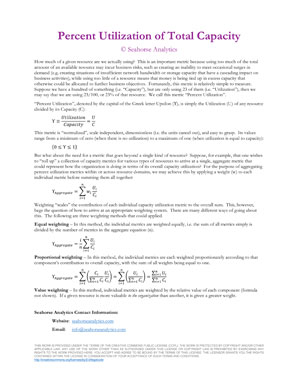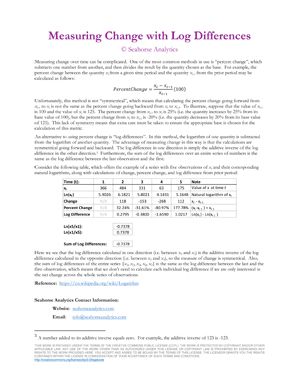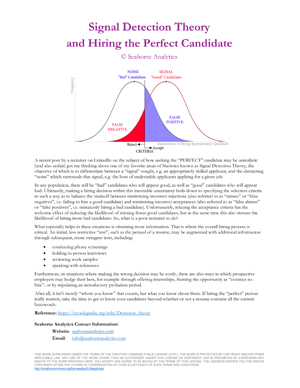Example Articles
Percent Utilization of Total Capacity
How much of a given resource are we actually using? This is an important metric because using too much of the total amount of an available resource may incur business risks, such as creating an inability to meet occasional surges in demand (e.g. creating situations of insufficient network bandwidth or storage capacity that have a cascading impact on business activities), while using too little of a resource means that money is being tied up in excess capacity that otherwise could be allocated to further business objectives. Fortunately, this metric is relatively simple to measure. Suppose we have a hundred of something (i.e. “Capacity”), but are only using 23 of them (i.e. “Utilization”), then we may say that we are using 23/100, or 23% of that resource. We call this metric “Percent Utilization”.
Measuring Change with Log Differences
Measuring change over time can be complicated. One of the most common methods in use is “percent change”, which subtracts one number from another, and then divides the result by the quantity chosen as the base. Unfortunately, this method is not “symmetrical”, which means that calculating the percent change going forward from a prior period to a subsequent period is not the same as calculating the percent change going backward from a subsequent period to a prior period. An alternative to using percent change is “log differences”. In this method, the logarithm of one quantity is subtracted from the logarithm of another quantity. The advantage of measuring change in this way is that the calculations are symmetrical going forward and backward.
Signal Detection Theory and Hiring the Perfect Candidate
How can a prospective employer differentiate between the "perfect" applicant and the host of undesirable applicants applying for a given job? Signal Detection Theory provides some insight into this question. In any population, there will be “bad” candidates who will appear good, as well as “good” candidates who will appear bad. Ultimately, making a hiring decision within this inevitable uncertainty boils down to specifying the selection criteria in such a way as to balance the tradeoff between minimizing incorrect rejections (also referred to as “misses” or “false negatives”, i.e. failing to hire a good candidate) and minimizing incorrect acceptances (also referred to as “false alarms” or “false positives”, i.e. mistakenly hiring a bad candidate).



